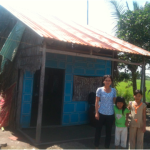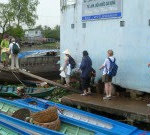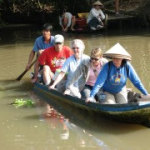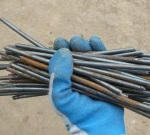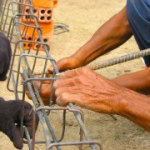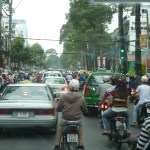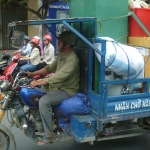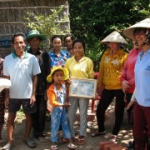Aren’t you too old for that?  That was a question posed to three sisters as we embarked on a trip to Vietnam in 2013 with Habitat for Humanity to help improve living conditions for low-income families. Find out how we responded to that question. Enjoy!
Thanks to the KERBY CENTRE for publishing our story and to Peggy Bell for her very fine writing and meticulous memory! Read the story in full print below this image. and read it here
October 2015 written by Peggy Bell
“It’s the best way to travel, learn and have fun”
Building Homes and Friendships
Aren’t you too old for that? That was a question posed to three sisters as we embarked on a trip to Vietnam in 2013 with Habitat for Humanity to help improve living conditions for low-income families.
We were age 62, 60 and 52 – hadn’t even thought about the age thing! Good thing we hadn’t because age doesn’t matter. This was our fourth trip traveling abroad with Habitat. All you need is a good attitude (anything can happen), a desire to learn, a sense of humor and a willingness to help and learn about a new culture from the people that live there. Oh, and a few clothes, work gloves, bug spray, and your passport.Â
We all come from different backgrounds. Louisa works in public health, Kathryn in property management, and I just retired a few years earlier from a long career in banking. I learned about Habitat for Humanity through their chapter in Southern Alberta where they have built 170 homes since their inception in 1990. Having zero construction skills, I started volunteering on the Calgary job site about 10 years ago and discovered the Habitat International building program that spans 93 countries and has built more than 800,000 homes worldwide.
Now, none of us 3 sisters had a clue about how you’d build a home in Vietnam but we loved to travel, we along well and thought, well why not? The three of us along with 5 other siblings had grown up in Zambia, Africa where our parents lived for 20 some years. Perhaps this was why we thought why not see the world and lend a hand at the same time? We haven’t looked back since.
Our trip to Vietnam was shared with 14 other people from all over the world. Canada, USA, Australia and the UK (six Canadians in the group, 4 from Calgary). We met up in Ho Chi Minh City. We were bombarded with the sights and sounds of a million motorbikes, sidewalk shops, markets, bicycles, monks, street vendors, and tiny back alleys, home to shops smaller than your walk-in closet, filled with exotic and colorful items that we thought we just had to have! We ate strange and wonderful food, sampled Vietnamese coffee, couldn’t speak the language, and met the gentlest and kindest people – and this was just our first night.Â
The next day we traveled to Each Gia south Vietnam to work on a Habitat project on the Mekong River where Habitat Vietnam partners with low-income families to build repair or upgrade their homes. The families contribute “sweat equity†or their own labor and typically repay the cost through micro-finance loans. International volunteers provide a hand up by building alongside the families.
A modest clean hotel was base for us for the next 10 days. We traveled to and from the worksite along the Mekong River by barge, fascinated to see giant barges laden with good, water taxis, the occasional swimmer and people doing their laundry – all part of life along the famous river.
Our teams were divided among three houses, for which we built new foundations. We would then move the homes onto the new foundation, providing them with a slab floor, a huge improvement that would help keep the inhabitants dry during the country’s torrential rains. Sounds simple and there was no cement or concrete mixers, just good old hand mixing, hauling buckets of concrete and cement by hand through the narrow gap between the houses, digging out trenches for the foundation wall by hand with shovels and buckets, bending rebar by hand using nothing but another piece of rebar, making wire forms for the concrete and more mixing mixing mixing of sand cement mortar and concrete.
The families we serve work alongside us, shy at first and w have a language barrier. But by the end of the day we are able to communicate through gestures, smiles, a helping hand, and the universal language of working together.Â
Each job site has a local foreman who directs us in our tasks, keeps us safe, translates for us, shows us how to lay bricks properly and straight, as well as the many other things needed to complete the foundation. We soon find out to work in a place with 100% humidity and 30% temperatures. You drink may more water than you thought possible and never have to seek out the toilet facilities (which are em, ah, “basicâ€).
During our frequent work breaks, we are delighted with our nutritious snacks – coconut water hacked open by the homeowner with a very large knife and fresh fruit picked up from the market on our way to the barge in the morning, mangosteen, rambutan, dragon fruit, the best little oranges you’ve ever tasted and sometimes delicious little cakes baked by the families, treats you’ve never imagined – worth the trip for the food alone!
We sometimes reached a house by canoe on which villagers prepared out lunch, most of which we couldn’t identify. But the food was always fresh, delicious and all locally sourced and grown. I think the local food craze in our part of the world started in Vietnam many years ago. A daily delicacy we came to love was a plant we grow in our gardens in Calgary – morning glory leaves saluted in soups and stews. Yum! The plant grows wild and is full of all those good things we need.
Time after lunch was for resting, visiting with the families and playing with the children. No matter what country you travel to and what language you speak or don’t, the appearance of a Frisbee, a skipping rope, or a ball works magic. The children were shy initially but by the time we left they had us giggling and laughing taking their photos and playing games, we’re forgotten how to play.
Work on a Habitat build generally continues for 3 or 4 days then we take a bit of a break to visit some of the local schools, clinics or other community facilities used by locals in their daily lives. This gives us a better understanding of the challenges faced in some developing countries and how people manage with few resources. We were constantly amazed at how they find solutions to their everyday challenges with such limited resources, another lesson learned.
One of the highlights of the trip was a school visit – you’d have thought we were royalty by the greeting we received. It wasn’t long before we had the kids skipping, playing Hokey Pokey, charades and ball sports while disrupting the whole school(we did see the head teacher smile a few times). Beautiful children despite extreme poverty, parents take great care to dress children as well as they are able in clean clothes. It was easy to see they were well loved and cared for.
After a full week or work and a school visit we had a bit of a break and headed off to a little island off the coast for some R&R – beaches, sun, quaint little town, a great coffee shop, some more good food, and even a bit of Wi-Fi. Some of us indulged in a massage on the beach – so inexpensive it was almost free. Â
A welcome break, then back to work on Monday were we were almost finished the floors and had to prepare ourselves for moving the house onto the new foundation. This involved waiting for the crane or some imagined “thing†to move the house…wondering how it would get here on the barge (we couldn’t see any major roads anywhere)…just wondering, what was the plan?
As usual, our Western way of wondering wasn’t going to make it happen. Our job site supervisor had a plan. We just had no idea what it was; wait another lesson about to be learned.
They say it takes a village to raise a child. Take that another direction; it takes a village to move a house! That’s exactly what happened. Our team along with numerous locals just picked up the straw wood hatch house and meter-by-meter moved it onto the new foundation. Who would have thought it possible? Not us! But another great lesson: if you don’t have what you need use what you have and it all works out.
The houses moved, the job complete, the families are presented with a small housewarming gift from the team – electric fans- a welcome addition to the heat. A few brave team members when shopping for fans earlier in the week on the back of a motorbike – very safe they said, but you’re on the road with thousands of other motorbikes that all seem to know exactly where they are going and always faster than you, no helmets, traffic lights or a mere suggestion and no right of way for pedestrians even on crosswalks. We found it best not to look just hand on!
A wonderful dedication ceremony ends the work. We leave knowing we did make a small difference to three families; they will have a solid dry foundation to weather the rainy season. We will have lasting memories of the wonderful people we met and worked within a country we know little about, but where we learned much.Â
Once the work is done, most Habitat team participants take the opportunity to visit other parts of the country – since you’re there so far away what a shame not to. Not enough space or time to tell about those few days, but Hanoi, Hoi An, Ha Long Bay ( a World Heritage site), temples and pagodas, floating villages, water puppets, Cambodia…the list is endless, the place is magical, the people wonderful…but that’s another story, for another time.
Over the past six years, the three of us sisters, along with my husband Rick and many other team members have been fortunate enough to travel with Habitat a half dozen times to Zambia and Vietnam. Friendships made on those trips have become close for some of us. It’s the best way to travel, learn and have fun.
Volunteers each pay their own way, plus airfare plus a donation to the local Habitat affiliate. These costs generally range from $3,000.00 to $5,000.00. depending on the location of the build. A charitable tax receipt for these costs is issued to each participant.
We’re just back again from Zambia where I have been privileged to lead teams, including a core group of Calgary volunteers, for the past five years. That this same core group returns, again and again, says a lot about this programs and the richness we come home with.Â
To learn more about this program, or to become involved in your own Habitat group here in Calgary, visit www.habitatsouthernalberta.c wwwhabitatglobalvilliage.ca

